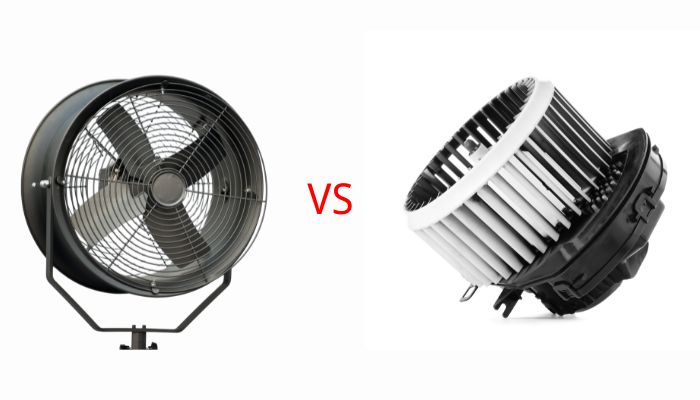Both fan and blower are commonly used for cooling and providing air circulation throughout buildings, internal spaces, outdoor environments, and more. They’re also vital components in HVAC systems. While ‘fans’ and ‘blowers’ are often synonymous, they have different functionalities, advantages, and applications.
Table of Contents
ToggleFans vs Blowers

Because fans and blowers are interchangeable, it’s important to know what you need for your specific application. Consider how the two differ in terms of functionality, common applications, and unique benefits.
Function
On the other hand, a fan consists of blades arranged around a central point and a motor that powers the fan and drives the blade motion. Electric motors generally power fans, but some models can use internal combustion engines or hydraulic motors. When you’re determining whether you need a fan or blower based on functionality, keep these two rules in mind:
- Blowers operate at moderate pressure, with an air pressure ratio of 1:1.1 to 1:1.2, and fans move large volumes of air with little to no change in air pressure. Blowers direct air in a specific direction, while fans circulate air throughout a defined space.
Applications
Fans and blowers are used for very different applications. The two typical applications of fans are:
- Cooling areas by moving the air Ventilating spaces, such as living areas
The typical applications of blowers are:
- Drying goods and surfaces by forcefully directing air toward it Cleaning surfaces and areas, like a leaf blower Increasing the size of a fire
Benefits
Both assemblies have vital benefits that will make them useful in your facility. The unique advantage of selecting a fan is its energy efficiency. They use less electricity than blowers that move the equivalent amount of air. Blowers, on the other hand, are advantageous because of the direct airflow and power they provide. Blowers also have a lower initial purchase price.
Other Compassions Between Fan And Blower
| Fan | Blower | |
| Definition | A fan circulates air around an entire room, or space. | A blower circulates the air only on the specific or pointed area. |
| Pressure | It is uses less pressure to produce large amounts of gas. | It is uses high pressure to produce large amounts of gas. |
| Pressure ratio | The ratio of pressure is below 1.1. | The ratio of pressure is from 1.1 to 1.2. |
| Air area | It provides air in the complete area. | It provides air in a specific location or point. |
| Types | Axial flow fans Centrifugal fans Cross- flow fans |
Centrifugal blowers Positive-displacement blowers. |
| Consists of | It consists of a motor and blades, which run of electricity. | It consists of a fan, outer cover, inlet, out-let. |
Should You Use a Fan or a Blower?
Now that you know more about the different uses and advantages of fans and blowers, you can better select the right fit for your needs. Consider these factors:
- Pressure:
- If you need a tool that increases air pressure, choose a blower.If you need air pressure to remain the same, choose a fan.
- If you have more power available, you can choose a blower.If you have less power available, choose a fan.
- Choose a blower if you need to direct air in a specific direction.If you need indirect airflow throughout a space, choose a fan.
Depending on your particular functions and capabilities, you can choose from multiple different fans and blowers. Fans come in axial, centrifugal, and cross-flow models, each providing different types of air motion; blowers are available in centrifugal and positive displacement models, which use different types of force to move the air from the inlet through the outlet and in a specific direction.
